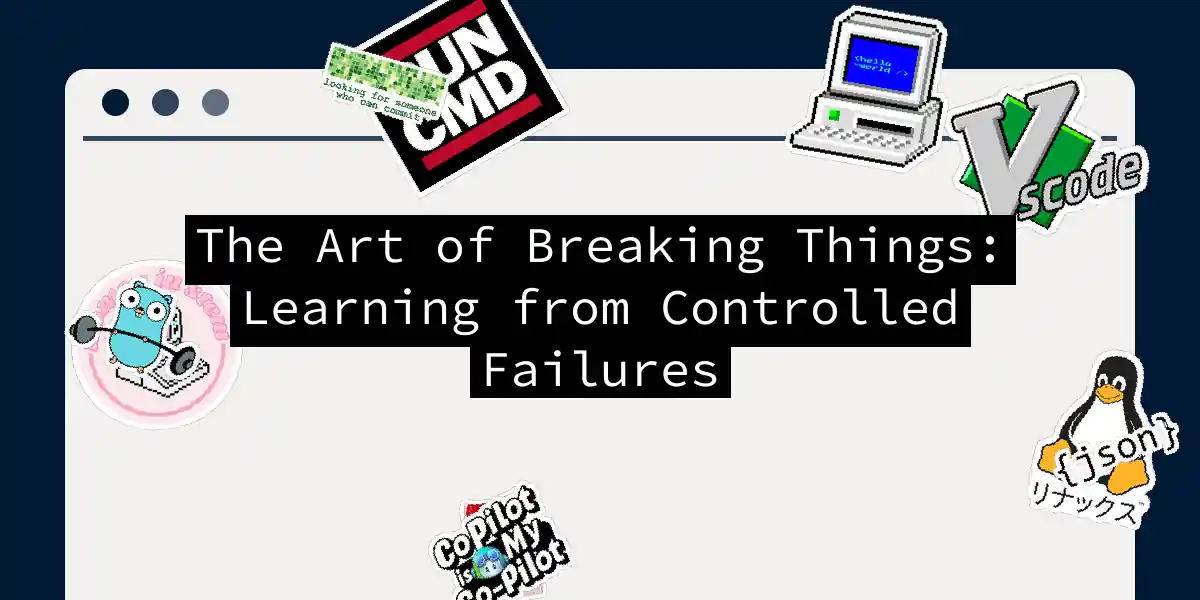Embrace the Glorious Crash
Picture this: you’re sipping coffee, code flowing like poetry, when suddenly—poof—your application nosedives into the digital abyss. Heart-stopping? Absolutely. But what if I told you these fiery crashes are your secret weapon? Welcome to controlled demolition for software, where we break things strategically to build indestructible systems. Failures aren’t disasters; they’re free lessons wrapped in error messages. As one industry analysis notes, most catastrophic software failures stem from tiny, preventable glitches. The trick? Force failures before they force you.
Why Break What Works?
Fail Fast: Digital Darwinism
“Fail Fast” isn’t just a bumper sticker—it’s survival of the fittest code. When your payment module implodes at 3 AM, you want that failure loud and immediate, not a silent corruption slowly eating data. Immediate feedback loops let you:
- 🔍 Pinpoint fractures like a code surgeon
- 🚑 Resurrect processes before users notice
- 🧪 Expose flaws that happy-path tests miss Take Elixir’s supervision trees—my personal crush. When a process trips, it doesn’t crawl into a corner to die. A watchdog instantly restarts it, like a robotic paramedic. No humans needed, just elegant chaos containment.
defmodule MyApp.Worker do
use GenServer
def start_link(_opts) do
GenServer.start_link(__MODULE__, :ok, name: __MODULE__)
end
def init(:ok) do
# Worker logic here
{:ok, %{}}
end
# Crash deliberately for demonstration
def handle_call(:breakme, _from, state) do
raise "Controlled demolition activated!"
{:reply, :ok, state}
end
end
# Supervision tree (lib/my_app/application.ex)
children = [
{MyApp.Worker, []}
]
Supervisor.start_link(children, strategy: :one_for_one)
Pro tip: Try GenServer.call(MyApp.Worker, :breakme) in IEx. Watch it respawn instantly.
The Cost of “It Works on My Machine”
History’s 37 most infamous software fails—from Mars landers to stock markets—share one flaw: inadequate testing. When we avoid controlled breaks:
- 💸 Errors compound into expensive disasters
- 🔥 Debugging becomes archaeology (digging through layers of “temporary” fixes)
- 😤 Users encounter Schrödinger’s bugs (fails randomly, vanishes when checked)
Breaking Things Professionally: Your Toolkit
Step 1: Design Sabotage-Ready Systems
Build systems that expect to fail. Apply these patterns:
| Technique | Implementation | Failure Response |
|---|---|---|
| Circuit Breaker | Stop requests when failures exceed threshold | Prevents cascade failures |
| Bulkheads | Isolate failures in partitions | Limits blast radius |
| Dead Letters | Route failed messages to quarantine | Post-mortem analysis |
# Python circuit breaker example (using pybreaker)
import pybreaker
breaker = pybreaker.CircuitBreaker(fail_max=3, reset_timeout=30)
@breaker
def process_payment(user_id, amount):
# Simulate unreliable payment gateway
if random.random() > 0.7:
raise PaymentGatewayError("Chaos monkey activated!")
return f"Payment processed for {user_id}"
# Test failure resilience
for _ in range(5):
try:
print(process_payment("user42", 99))
except pybreaker.CircuitBreakerError:
print("⛔ Breaker tripped! Cooling down...")
Step 2: Chaos Engineering Drills
Controlled failures need rehearsals. Here’s your battle plan:
- Map critical paths (What kills us if it breaks?)
- Inject failures:
- Network latency spikes
- Third-party API shutdowns
- Database connection leaks
- Measure survival metrics:
# Monitor with Prometheus http_requests_total{status="500"} / rate(http_requests_total[5m]) - Automate recovery (self-healing > heroics)
Step 3: The Memento Mori Dashboard
Build a “death memorial” for failures:
- 📉 Error rate heatmaps by service
- ⚰️ Autopsy reports for every crash
- 🎯 Mean Time to Repair (MTTR) tracker
Cultural Detonations
Rewrite Your Team’s DNA
- Blameless post-mortems: No villains, just root causes. Call them pre-mortems for future failures.
- Failure festivals: Celebrate “best crash of the week” with nachos. (My team awards a 💀 trophy)
- Resume-driven development: Encourage engineers to proudly list how they broke systems on their resumes.
“Failing early gives you the opportunity to recover before small cracks become canyons.” — Agile wisdom
Conclusion: Break to Build Better
Controlled failures turn you from a firefighter into a fire architect. When that next error erupts, don’t panic—pop champagne. You’ve just been handed a free upgrade to your system’s antifragility. Now go forth and strategically dismantle your creations. (Responsibly, of course—we’re professionals, not cartoon villains.) What spectacular breaks will you engineer this week? Share your demolition stories @MaximCodes.
